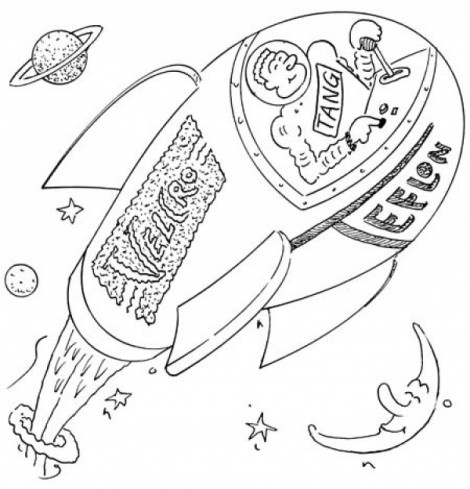
I once heard NASA was the only government department to show a profit due to patents on things such as Teflon, Velcro, and Tang. Any truth to this? —Michelle, Anchorage
Will this silly story never die? I’ve mentioned previously that NASA didn’t invent Teflon, Velcro, or Tang; we therefore deduce that it can’t be making money on the patents. This evidently made no impression the first time, so let’s go over it again:
Teflon was invented by Roy J. Plunkett in 1938 while he was experimenting with refrigerants at DuPont Labs. His patent was granted in 1941.
Velcro was invented by Swiss electrical engineer Georges de Mestral, who said he got the idea from burrs he picked up on a hike. He obtained a patent on his hookand-loop fabric fastener in 1955.
Tang was invented in 1957 by General Foods researcher William A. Mitchell.
Tang did go into orbit with John Glenn in 1962, and NASA’s use of all three items heightened their profile. Had NASA been a little more hip to the product-placement possibilities, I suppose it might have extracted fees from the lucky vendors, or at least gotten a break on price. However, I find no evidence it got either.
On the larger question, a look at NASA’s 2008 balance sheet shows it sure isn’t making money as that notion is ordinarily understood: I’m seeing $1 billion in earned revenue vs. $19 billion in gross operating costs, with the difference mostly coming out of our collective wallet. Needless to say, the government as a whole is so far in the red that it’s starting to interfere with microwave transmissions. Such quibbles aside, agencies that can be said to be making a buck include:
Bureau of Engraving and Printing. You’d think the surest way to make money would be to literally manufacture it. Maybe not. For fiscal 2007, the Bureau of Engraving and Printing, which prints paper currency, netted $46 million, but it lost $17 million in 2008.
U.S. Mint. The mint is a more dependable moneymaker, netting more than $1 billion in 2007 and $800 million in 2008. Why does it do so much better than the BEP? Because the BEP is essentially a printer, selling paper currency to the Federal Reserve at cost. By tradition, however, the mint sells its coins at face value. The difference between that and the cost of production is called seigniorage—profit to you and me.
Bureau of Land Management. The BLM, which oversees the rape—sorry, the development of resources on 13 percent of the total U.S. land area, regularly sells off leases for oil and gas drilling, coal mining, grazing, and so on. In 2005, revenue from mineral leases alone generated more than $3.4 billion. Cost to run the bureau that year: $837 million.
Federal Communications Commission. The FCC occasionally sells off public assets at a profit—like in March 2008, when it auctioned off the soon-to-be-abandoned 700MHz analog television band, which garnered $19.6 billion. FCC budget for 2008: $313 million.
Internal Revenue Service. According to the General Accounting Office, in fiscal 2008 the IRS had a budget of $11.2 billion but squeezed tax cheats for $56.4 billion.
Tennessee Valley Authority, etc. Fact is, if you go through the Treasury Department’s monthly statements—a process that’s every bit as fascinating as it sounds—you find a number of agencies either turning a profit or pulling in significant cash. The TVA, for example, cleared $817 million in 2008, mostly from selling electricity. The Nuclear Regulatory Commission covers 90 percent of its budget from user fees. They’re the exception, though. The bulk of the government operates at a dead loss, and all we get out of it is prosperity (usually), the freedom to watch Dancing With the Stars, and peace—if not everywhere, at least here.
Something From Nothing
In your column about scooter vs. SUV pollution [“To Drive or to Scoot,” March 26, City Weekly], you said: “At 19.4 pounds of CO 2 per gallon of gas, an average SUV emits 1,050 pounds of CO 2 per thousand miles, while the average scooter emits 259 pounds.” Gasoline weighs from 5.8 to 6.5 pounds per gallon depending on the ethanol mix. So how can a gallon of gasoline produce 19.4 pounds of CO 2 ? —Don Rosenberger, Renton, Washington
The extra mass comes out of thin air—literally. Each carbon atom in the gasoline combines with two oxygen atoms to make CO 2 . Since the oxygen has a relative weight of about 32 (16 per atom) and the carbon a relative weight of about 12, CO 2 has a relative weight of about 44. Since 44 divided by 12 is 3.67, a pound of carbon makes 3.67 pounds of CO 2 . I’ll skip the rest of the math; suffice it to say that the emissions you wind up with weigh more than the original gas.
Comments, questions? Take it up with Cecil on the Straight Dope Message Board, StraightDope.com, or write him at the Chicago Reader, 11 E. Illinois, Chicago 60611.